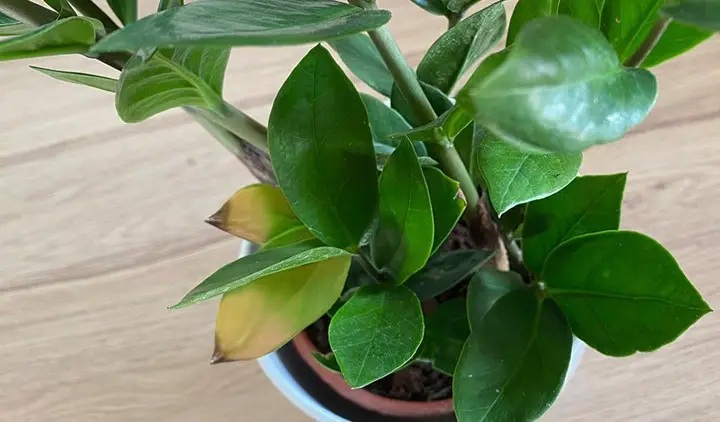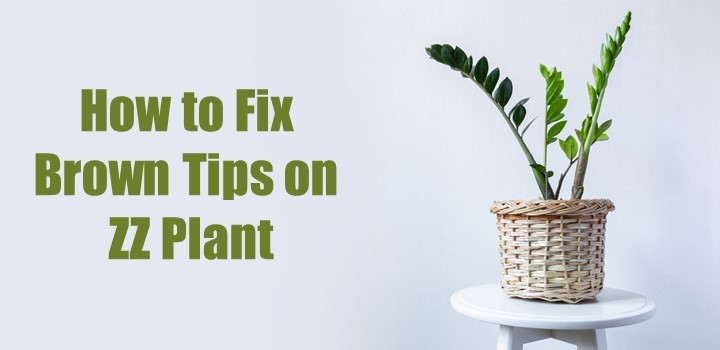ZZ or the Zanzibar gem plant is a flowering perennial of the African region. Due to its ability to clean indoor air from different pollutants, it has become a good pick for plant lovers.
Being native to the tropical region, this plant endures a lot in other parts. Besides, you know that houseplants need a bit extra attention due to a lack of adaptability in adverse weather conditions. Most commonly foliage issues are mentioned.
ZZ plant tips are quite sensitive to browning. This issue is even more serious in the winter season. You might have faced the same, right? Well, not to be worried as here I have come up with all your solutions related to leaf tip browning in the ZZ plant.
Before jumping to the article, let’s take a look at what I have brought for you. Here I will discuss some common mistakes that may cause browning tips such as inappropriate watering, excessive heat exposure, over-fertilizing and ignoring low humid conditions, and root issues.
So, let’s take a look at how you can combat these issues for your ZZ plant.
Troubleshooting Brown Tips on ZZ Plant

1. Inappropriate Watering
Brown leaf tips on the ZZ plant can primarily evolve due to inconsistency in watering. Both over and under watering can promote such a case.
So, if you observe brown tips on your ZZ plant leaves, I would suggest having a check on your watering schedule. Most of the houseplant needs gradual watering.
If your pot is filled with water and the soil remains wet for a longer period, the soil lacks air pockets. Such condition restricts oxygen supply to plants and this is why leaves start browning starting from the tip.
On the other hand, underwatering can cause wilting as well as drying up the whole plant before leaf tip drying. So, wilting is a common symptom by which you can detect what kind of watering your plant needs.
Now, let’s check how to deal with watering issues in the ZZ plant. Here I have noted some for you. Have a look.
Control Measure
Before permitting water in your plant check the moisture level. Sometimes soil may seem to be crusty on the surface but still, the plant can have enough water. So it’s better to test at a depth of 4 to 5 cm depth. If the soil feels dry at this level, add adequate water.
Normally, applying 1-2 cups of water per 14-20 days is considered to be okay for the ZZ plant. Still, if your plant shows wilting symptoms with crusty soil, you may minimize the gap between the two watering schedules.
You may also overwater your plant, or sometimes due to drainage hole blockage. So, the excess water may accumulate in the pot. In such a case it’s advised to place the plant in a sunny place immediately. Then try to clear the drainage path to let the water runoff.
If the issues extend to brown tips in some leaves, it’s better to trim off the affected parts for a healthy-looking plant.
2. Excessive Heat Exposure
Heat damage and scorch problems are very common in houseplants. As these are not likely to be adapted to direct sunlight for a longer time, that’s why it’s a bit hard for them to survive such damage.
Too much sunlight with heat causes more transpiration resulting in water loss for the ZZ plant. Your plant may also struggle for water uptake from the soil in this condition. So to reduce this stress, you need to be a bit careful about sun exposure to your plant.
Control Measure
Burnt tips may not be revived but some care can help you to save the plant from such damage. Let’s take a look.
First of all, place it in a shady place and put as much water as it needs. You can also add some mulch around the roots to conserve moisture for some time. This will lessen the effect of excessive heat.
Then you have to keep an eye on the plant how it’s reacting. Allow some water if further wilting symptoms exceed.
Last but not the least, check the weather condition before placing it in a sunny place again. It’s better to avoid direct sun for your ZZ plant when the temperature is around 35°C. You may need to wait a couple of weeks before doing so.
Now, another question may arise here, is it’s needed to cut off the damaged leaf tips? Well, not all the time. In heat damage, it’s better to give your plant a break to recover on its own. Trimming of damaged leaves will allow new foliages which are even more prone to sun damage.
How to Prevent Sun Damage?
It’s true that you can’t skip heat all the time. So you can adapt some measures which will look after further issues.
It’s a good option to cover your plants on scorching summer days. Shade cloth or polythene may help you in this.
You can also use antitranspirant spray which will protect plants from direct heat. This spray can save for new growths in your plants.
3. Low Humidity
Such humidity issues are seen in ZZ plants grown in the arid regions. Insufficient moisture in the air causes leaf tips to turn brown.
You may not be able to control such weather conditions. So it’s better to follow some steps to save your plant from humidity issues.
Control Measure
You can spray some water around the plant to increase the humidity in the air. You can also mist on your foliage. But be careful not to overwater the plant as it may promote fungal attack to the plant.
Gathering multiple plants together also creates a humid condition as this increases transpiration. So you can also try the grouping technique.
Using a pebble tray is another good option. It’s quite helpful to increase local humidity. In this method, you have to take a pot at least twice the diameter of your pot and is placed beneath it. Then some pebbles are shredded on the tray at one-inch depth.
On the last note, you can use an air humidifier for local enhancement of humidity in the winter season. It’s quite effortless and convenient.
4. Salt Build-up in the Soil
Excessive use of fertilizer can promote salt build-up in pot soil. A crusty layer of salt is the indication of such a condition.
These build-ups restrict moisture in the soil to plant roots and create an artificial drought condition. As a result plant leaf tips start to turn brown.
Moreover, direct contact with some fertilizer also causes burn to plant leaves. As tips are more susceptible to damages these start burning fast.
However, you don’t need to be worried much. Here are some of my suggestions. Keep reading.
Control Measure
Start with restricting fertilizer use for at least one month. In this period, if needed, you can put some organic manure according to your plant need,
Then remove the salt layers created by excess fertilizer. After that put some water which will allow to leach off the salts in deeper levels. In this case, don’t forget to check the drainage hole before applying water.
It’s always a wise option to pick a fertilizer that has a balanced dose of all the necessary nutrients. Here is my recommendation –Aquatic Arts Indoor Plant Food
5. Damaged Roots
Root damage also causes edge and tip browning in the ZZ plant. So, you need to keep checking your roots more often in your houseplants.
Well, some symptoms may help you to detect root problems in your plant. Wilting and faded leaves are primary signs which may promote brown leaf tips in your ZZ plant.
Most of the time roots of the houseplants cluster together in smaller spaces and thus such conditions arise. So, you must keep an eye on this issue.
And it’s really important to treat such damages as they may kill the whole plant gradually. Now let’s take a look at how you can deal with root problems related to brown leaf tips.
Control Measure
First of all, if grown in a smaller pot, repot your ZZ plant by trimming damaged parts to a fresh medium with more space for roots. This will allow better growth. Choose your pot wisely according to the plant size.
Next comes foliage trimming. I know it’s a bit heartbreaking, but trust me, this will prompt the new root growth and in a few days you will notice fresh leaves along with a bright canopy.
Last but not the least, focus on the root rot issues. If you observe wet roots with fungal infections it’s advised that after removing the affected part, you should use a fungicide to the soil (our pick: Bonide (BND951) – Systemic House Plant Insect Control). This will control further damage as well as minimize the current one.
Conclusion
In this article, I have tried to target the leaf tip browning of your ZZ plant. After going through the whole one, hope you have gained quite some clear ideas of how you can deal with this problem.
Let’s sun up now. So, you have to check the weather conditions on the first note. Take a step according to your needs. Then you have to look for root issues and add a balanced fertilizer, as simple as it is!
So what are you waiting for? Start pampering your plant with some good care. Come back to us if you feel you may have missed something, Our comment section is open for you.
